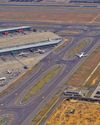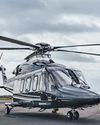
This colossal aircraft, aptly named for its potential to soar through the skies like a veritable giant among planes, stands poised to revolutionise not only the transportation sector but also the renewable energy industry. Aerospace engineer Mark Lundstrom believes he has the key to revolutionising renewable energy: constructing the largest aeroplane in the world. With over seven years of collaboration with an engineering team, Lundstrom, an MIT-trained rocket scientist and Rhodes scholar, has spearheaded the design of the WindRunner—a colossal cargo plane aimed at transforming the renewable energy landscape.
Crafted by the skilled hands and creative minds at Radia, a Colorado-based energy company known for pushing the boundaries of innovation, the Windrunner is more than just an aircraft — it's a game-changer. With dimensions that defy imagination, this behemoth of the skies stretches an impressive 356 feet in length and towers to a height of 79 feet, boasting a wingspan that spans an awe-inspiring 261 feet. To put this into perspective, it's nearly as long as a regulation NFL football field and surpasses the world's longest passenger plane, the Boeing 747-8, by a staggering 106 feet.
Radia is placing its bets on the future demand for larger and more potent wind turbines. According to the latest research, the investment in onshore wind technology is projected to soar to $10 trillion by 2050. The upcoming GigaWind turbines, renowned for their immense power, boast significantly larger blades and are expected to yield profits two to three times greater than their present-day counterparts.
Bu hikaye Cruising Heights dergisinin April 2024 sayısından alınmıştır.
Start your 7-day Magzter GOLD free trial to access thousands of curated premium stories, and 9,000+ magazines and newspapers.
Already a subscriber ? Giriş Yap
Bu hikaye Cruising Heights dergisinin April 2024 sayısından alınmıştır.
Start your 7-day Magzter GOLD free trial to access thousands of curated premium stories, and 9,000+ magazines and newspapers.
Already a subscriber? Giriş Yap

Taking Off: The rise of personalised IFE
In-flight entertainment systems now play a big part in how airlines are perceived by passengers. Increasingly, these IFE systems are getting sophisticated and highly customised to cater to individual tastes,

NIA and NMIA— a giant leap for Indian aviation
Two landmark airports — Navi Mumbai and Noida International Airport in Greater Noida are scheduled to be inaugurated in the coming weeks with commercial operations later this year. Ameya Joshi reports on how transformative the new airports will be for Indian Aviation

Green Airports and Key Sustainability Initiatives
As the aviation industry faces increasing scrutiny over its environmental impact, the transition to sustainable airports represents a significant step forward. These airports prioritise the use of renewable energy sources, such as solar and wind power, and energy-efficient technologies to optimize energy consumption, reports Rasheed Kappan

Offshore helicopter sector's rebound
From near collapse to a sudden boom, the offshore helicopter sector has experienced a dramatic turnaround. After years of struggling with overcapacity, low utilisation and pandemic-related pressures, the industry is now facing a new challenge meeting soaring demand.

What is in store for India's commercial aviation market?
2024 has been a difficult year for Aviation. A significant concern has been the persistent disruptions in the supply chain that are impacting aircraft manufacturers and their suppliers. Consequently, airlines have been compelled to either postpone their expansion plans or depend on older fleets, which are less fuel-efficient and entail higher maintenance costs.

General Aviation Fueling India's Growth!
India's aviation sector is experiencing an unprecedented surge, fueled by rapid economic growth, increasing wealth, and expanding aviation infrastructure. As the world's fastest-growing aviation market, India presents immense opportunities in the mobility and travel industry. Part of the larger aviation ecosystem is the lesser-known General Aviation industry, which is also playing a pivotal role as part of the aviation ecosystem. Some of the key stakeholders of the General Aviation Industry are Flying Training Organisations, Drone/EVTOL manufacturers, DAAS (Drone as a Service) providers, and of course, the blue-eyed Charter Operators (Private Aviation).

Expanding Horizons
Entering the Indian market in early 2024, Universal Vulkaan Aviation (UVA) has quickly adapted to the country's dynamic and diverse aviation sector. With a focus on regional strategies and value-driven solutions, the company has achieved significant milestones. KARAN SETHI, Managing Director, Universal Vulkaan Aviation (UVA), highlights their success with the AW169 and their commitment to enhancing MRO services to cater to India's unique market demands.

Boeing-A time-tested partner whose footprint continues to grow and expand
Boeing brings over 80 years of experience in India, making us a reliable partner for the nation's expanding aviation industry. The American aerospace giant's significant investments in supply chain partnerships, engineering, research and development, training, co-production, and co-development set us apart as a trusted ally in supporting this growth. An exclusive conversation with RYAN WEIR, Vice President, Commercial Sales and Marketing, India & South Asia, Boeing Commercial Airplanes. Excerpts

AI in Aviation Transforming India's Skies and Beyond
The accelerated adoption of technology and the integration of Artificial Intelligence are facilitating a significant transformative change that holds the potential to redefine the travel experience. PRASANNA SUBRAMANIAM, Chief Technology Officer, Fly91, outlines the potential and the possibilities.

Bringing our expertise to India
India represents a rapidly expanding market for airport logistics, propelled by significant increases in passenger traffic and ongoing infrastructural advancements. Alstef Group is actively seeking opportunities to leverage its expertise TENNYSON ANTHONY, Managing Director, Alstef Group, outlines the company's strategy.